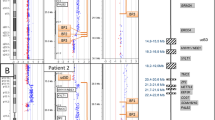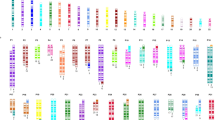Abstract
During a 6-year period, 590 patients suspected of having a minor or cryptic genomic imbalance as the cause of mental retardation with dysmorphic signs +/− malformations have been investigated with high-resolution comparative genomic hybridisation (HR-CGH) in our diagnostic laboratory. Thirty-six patients had a small chromosomal aberration detected by routine karyotyping, and 554 patients had a normal G-banded karyotype. In the latter group, a genomic imbalance was detected by HR-CGH in 40 patients (7.2%): 29 deletions, 3 duplications, 4 unbalanced translocations, and 4 occult trisomy mosaicisms. When microarray-based comparative genomic hybridisation (array-CGH) became available, all HR-CGH-positive samples were also investigated by 1 Mb resolution array-CGH for more precise mapping. From the 514 patients with normal HR-CGH findings, a subset of 20 patients with particularly high suspicion of having a chromosomal imbalance was selected for array-CGH. In four of them (20%), an imbalance was detected: three deletions and one duplication. Of note, 73 out of the 80 array-CGH mapped patients had a de novo chromosomal rearrangement (91%). Taken together, this work provides phenotype–genotype information on 80 patients with minor and cryptic chromosomal imbalances.
Similar content being viewed by others
Log in or create a free account to read this content
Gain free access to this article, as well as selected content from this journal and more on nature.com
or
References
Gustavson KH, Holmgren G, Blomquist HK : Chromosomal aberrations in mildly mentally retarded children in a northern Swedish county. Upsala J Med Sci 1987; 44: 165–168.
Stromme P, Valvatne K : Mental retardation in Norway: prevalence and sub-classification in a cohort of 30037 children born between 1980 and 1985. Acta paediatr (Oslo, Norway) 1998; 87: 291–296.
Roeleveld N, Zielhuis GA, Gabreels F : The prevalence of mental retardation: a critical review of recent literature. Dev Med Child Neurol 1997; 39: 125–132.
van Karnebeek CD, Jansweijer MC, Leenders AG, Offringa M, Hennekam RC : Diagnostic investigations in individuals with mental retardation: a systematic literature review of their usefulness. Eur J Hum Genet 2005; 13: 6–25.
Rauch A, Hoyer J, Guth S et al: Diagnostic yield of various genetic approaches in patients with unexplained developmental delay or mental retardation. Am J Med Genet 2006; 140: 2063–2074.
Kirchhoff M, Rose H, Lundsteen C : High resolution comparative genomic hybridisation in clinical cytogenetics. J Med Genet 2001; 38: 740–744.
Ness GO, Lybaek H, Houge G : Usefulness of high-resolution comparative genomic hybridization (CGH) for detecting and characterizing constitutional chromosome abnormalities. Am J Med Genet 2002; 113: 125–136.
Kirchhoff M, Gerdes T, Maahr J et al: Deletions below 10 megabasepairs are detected in comparative genomic hybridization by standard reference intervals. Genes Chromosomes Cancer 1999; 25: 410–413.
de Vries BB, Pfundt R, Leisink M et al: Diagnostic genome profiling in mental retardation. Am J Hum Genet 2005; 77: 606–616.
Menten B, Maas N, Thienpont B et al: Emerging patterns of cryptic chromosomal imbalance in patients with idiopathic mental retardation and multiple congenital anomalies: a new series of 140 patients and review of published reports. J Med Genet 2006; 43: 625–633.
Schoumans J, Ruivenkamp C, Holmberg E, Kyllerman M, Anderlid BM, Nordenskjold M : Detection of chromosomal imbalances in children with idiopathic mental retardation by array based comparative genomic hybridisation (array-CGH). J Med Genet 2005; 42: 699–705.
Shaffer LG, Bejjani BA : Medical applications of array CGH and the transformation of clinical cytogenetics. Cytogenet Genome Res 2006; 115: 303–309.
Shaw-Smith C, Redon R, Rickman L et al: Microarray based comparative genomic hybridisation (array-CGH) detects submicroscopic chromosomal deletions and duplications in patients with learning disability/mental retardation and dysmorphic features. J Med Genet 2004; 41: 241–248.
Vissers LE, de Vries BB, Osoegawa K et al: Array-based comparative genomic hybridization for the genomewide detection of submicroscopic chromosomal abnormalities. Am J Hum Genet 2003; 73: 1261–1270.
Shaffer LG, Kashork CD, Saleki R et al: Targeted genomic microarray analysis for identification of chromosome abnormalities in 1500 consecutive clinical cases. J Pediatr 2006; 149: 98–102.
Kirchhoff M, Gerdes T, Rose H, Maahr J, Ottesen AM, Lundsteen C : Detection of chromosomal gains and losses in comparative genomic hybridization analysis based on standard reference intervals. Cytometry 1998; 31: 163–173.
Fiegler H, Carr P, Douglas EJ et al: DNA microarrays for comparative genomic hybridization based on DOP-PCR amplification of BAC and PAC clones. Genes Chromosomes Cancer 2003; 36: 361–374.
Meza-Zepeda LA, Kresse SH, Barragan-Polania AH et al: Array comparative genomic hybridization reveals distinct DNA copy number differences between gastrointestinal stromal tumors and leiomyosarcomas. Cancer Res 2006; 66: 8984–8993.
Wang J, Meza-Zepeda LA, Kresse SH, Myklebost O : M-CGH: analysing microarray-based CGH experiments. BMC Bioinform 2004; 5: 74.
Ballif BC, Wakui K, Gajecka M, Shaffer LG : Translocation breakpoint mapping and sequence analysis in three monosomy 1p36 subjects with der(1)t(1;1)(p36;q44) suggest mechanisms for telomere capture in stabilizing de novo terminal rearrangements. Hum Genet 2004; 114: 198–206.
Zweier C, Albrecht B, Mitulla B et al: ‘Mowat–Wilson’ syndrome with and without Hirschsprung disease is a distinct, recognizable multiple congenital anomalies–mental retardation syndrome caused by mutations in the zinc finger homeo box 1B gene. Am J Med Genet 2002; 108: 177–181.
Hoyer J, Dreweke A, Becker C et al: Molecular karyotyping in patients with mental retardation using 100K single-nucleotide polymorphism arrays. J Med Genet 2007; 44: 629–636.
Rosenberg C, Knijnenburg J, Bakker E et al: Array-CGH detection of micro rearrangements in mentally retarded individuals: clinical significance of imbalances present both in affected children and normal parents. J Med Genet 2006; 43: 180–186.
Kleefstra T, Brunner HG, Amiel J et al: Loss-of-function mutations in euchromatin histone methyl transferase 1 (EHMT1) cause the 9q34 subtelomeric deletion syndrome. Am J Hum Genet 2006; 79: 370–377.
Slager RE, Newton TL, Vlangos CN, Finucane B, Elsea SH : Mutations in RAI1 associated with Smith–Magenis syndrome. Nat Genet 2003; 33: 466–468.
Iafrate AJ, Feuk L, Rivera MN et al: Detection of large-scale variation in the human genome. Nat Genet 2004; 36: 949–951.
Sebat J, Lakshmi B, Troge J et al: Large-scale copy number polymorphism in the human genome. Science 2004; 305: 525–528.
Redon R, Ishikawa S, Fitch KR et al: Global variation in copy number in the human genome. Nature 2006; 444: 444–454.
Appukuttan B, Gillanders E, Juo SH et al: Localization of a gene for Duane retraction syndrome to chromosome 2q31. Am J Hum Genet 1999; 65: 1639–1646.
Jacquemont ML, Sanlaville D, Redon R et al: Array-based comparative genomic hybridisation identifies high frequency of cryptic chromosomal rearrangements in patients with syndromic autism spectrum disorders. J Med Genet 2006; 43: 843–849.
Kitsiou-Tzeli S, Sismani C, Ioannides M et al: Array-CGH analysis and clinical description of 2q37.3 de novo subtelomeric deletion. Eur J Med Genet 2007; 50: 73–78.
Edelmann W, Zervas M, Costello P et al: Neuronal abnormalities in microtubule-associated protein 1B mutant mice. Proc Natl Acad Sci USA 1996; 93: 1270–1275.
Lynch MF, Fernandes CJ, Shaffer LG, Potocki L : Trisomy 14 mosaicism: a case report and review of the literature. J Perinatol 2004; 24: 121–123.
Ballif BC, Rorem EA, Sundin K et al: Detection of low-level mosaicism by array CGH in routine diagnostic specimens. Am J Med Genet A 2006; 140: 2757–2767.
Acknowledgements
All the routine karyotyping was performed by the cytogenetic team working at the diagnostic laboratory at Haukeland University Hospital, led by Kjetil Solland. The genomic microarrays were produced by the Norwegian Microarray Consortium (NMC) supported by the functional genomics programme (FUGE) of the Research Council of Norway. We are especially grateful to the many clinicians who have contributed patients and phenotype information to this study: Marit Mork, Gro Zanussi, Inger Hellerdal-Rasmussen, Solfrid Larsen, Hallvard Reigstad, Christoffer Jonsrud, Gitte Vinther, Per Helge Kvistad, Nina Øyen, Finn Aspelund, Jarl Moldestad, Petter Strømme, Kristian Sommerfelt, Arve Vøllo, Arne Stubdal, Karen Helene Ørstavik, Gunnar Helland, Cathrine Helleland, Arvid Heidberg, Einar Heiervang, Andreas R Zagon, Trine Prescott, Trond Ludvigsen, Ineke Hogenesch, Lise Reindal, Carsten Muller, Gyri Aasland Gradek, Gyro Aas Herder, Arne Bjørnetun, Askild Stormorken, Henning S Aabech, Bente Ødegård, Viggo Lütschereth, Liv Marie Lægreid, Olav Roti, Tore Hågård, Martine Jaatun, Jan Olme, Bjug Åkre, Einar Bryne, Anne Lise Høyland, Kathinka Aslaksen, Asbjørg Stray-Pedersen, Sigurd Børsting, Ivar Mæhle, Ewa Czarnecka, Kathrine Bjørgo, Kristoffer Helland-Hansen, Anne-Lene Søhoel, Valeria Marton, Peter Juliusson, Pål R Njølstad, Olav Skogen, and Irene Øversveen.
Author information
Authors and Affiliations
Corresponding author
Rights and permissions
About this article
Cite this article
Lybæk, H., Meza-Zepeda, L., Kresse, S. et al. Array-CGH fine mapping of minor and cryptic HR-CGH detected genomic imbalances in 80 out of 590 patients with abnormal development. Eur J Hum Genet 16, 1318–1328 (2008). https://doi.org/10.1038/ejhg.2008.78
Received:
Revised:
Accepted:
Published:
Issue date:
DOI: https://doi.org/10.1038/ejhg.2008.78
Keywords
This article is cited by
-
A novel de novo 2.5 Mb microdeletion of 7q22.1 harbours candidate gene for neurobehavioural disorders and mental retardation
Journal of Genetics (2014)
-
Mosaicism for combined tetrasomy of chromosomes 8 and 18 in a dysmorphic child: A result of failed tetraploidy correction?
BMC Medical Genetics (2009)
-
An 8.9 Mb 19p13 duplication associated with precocious puberty and a sporadic 3.9 Mb 2q23.3q24.1 deletion containing NR4A2 in mentally retarded members of a family with an intrachromosomal 19p-into-19q between-arm insertion
European Journal of Human Genetics (2009)



